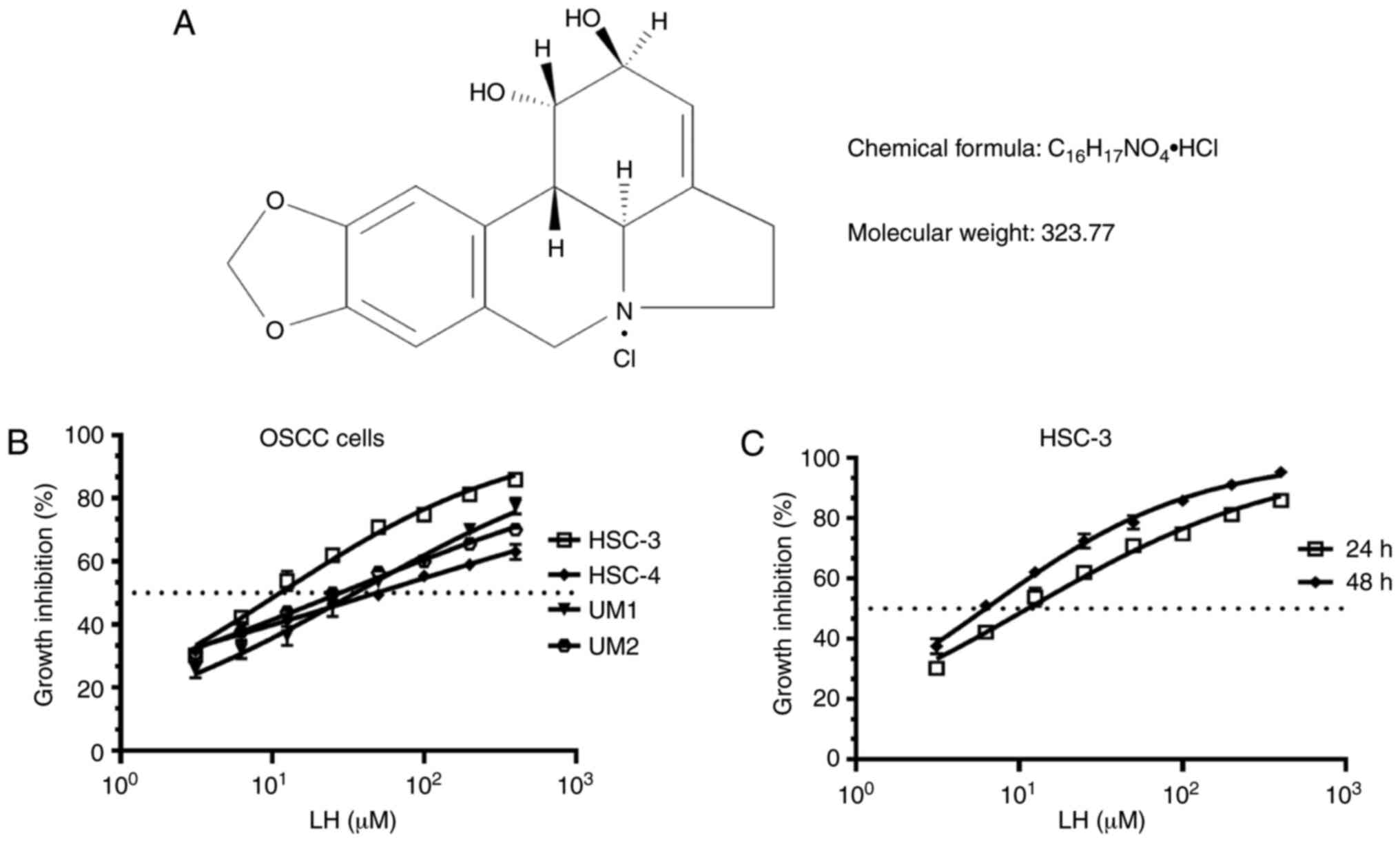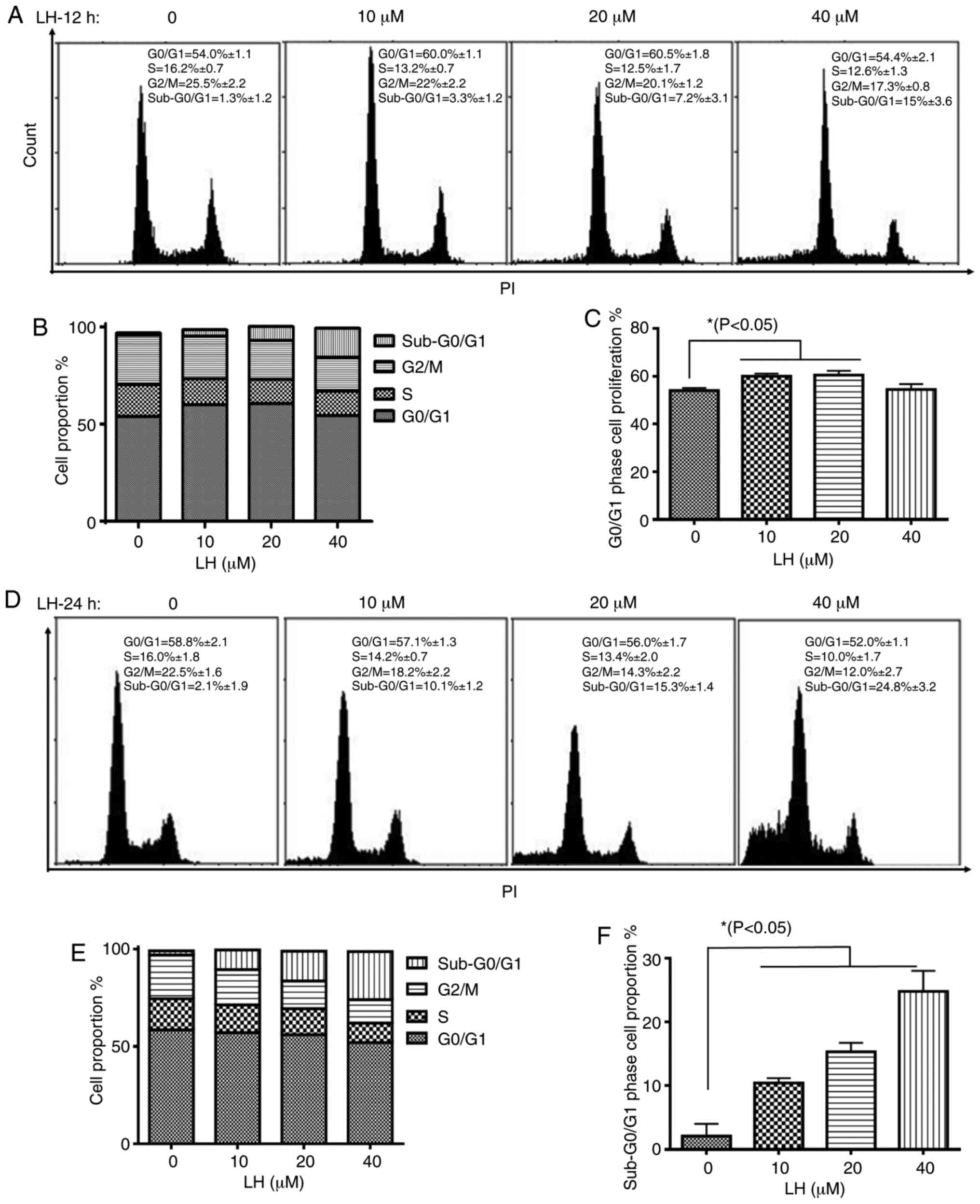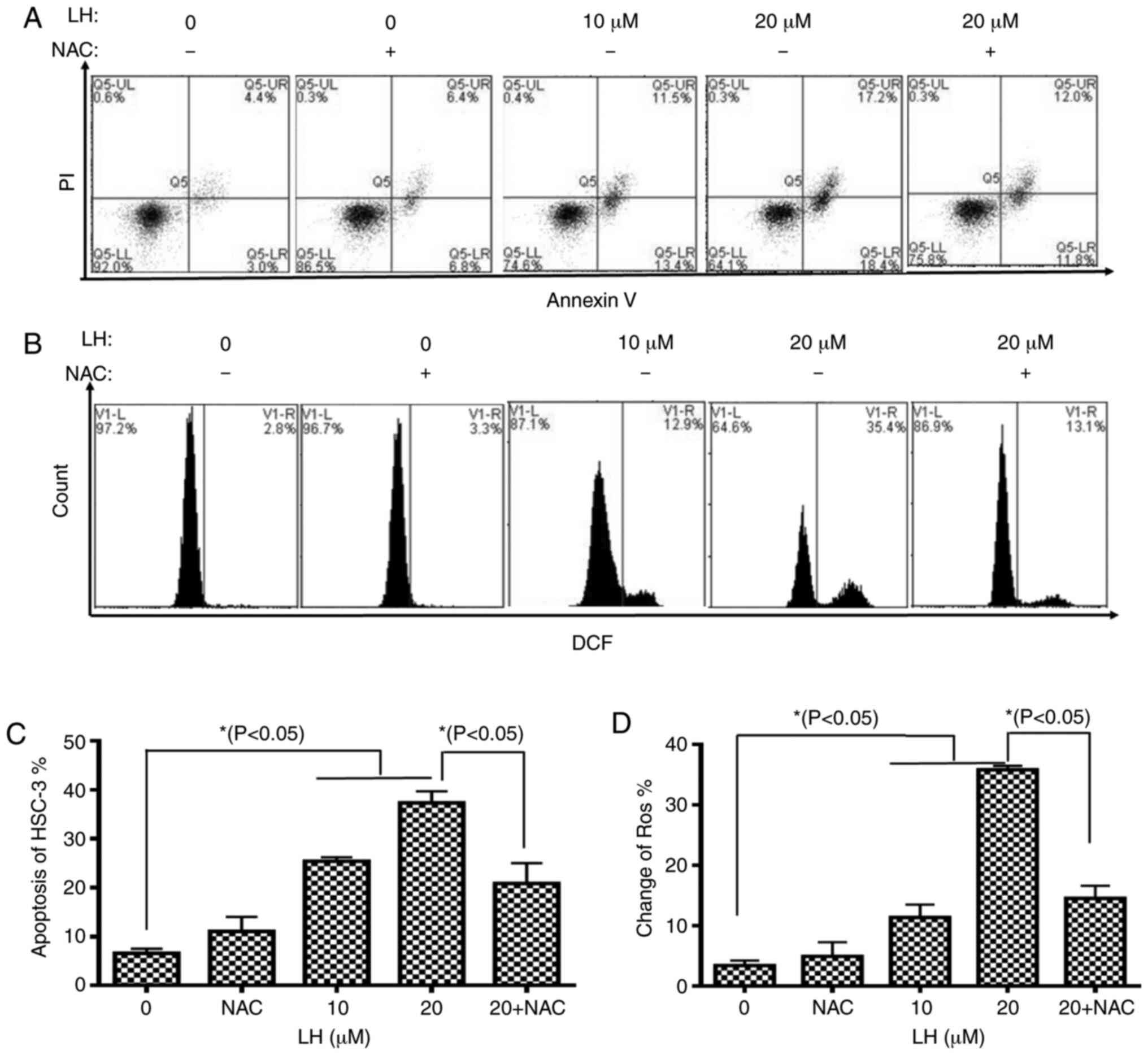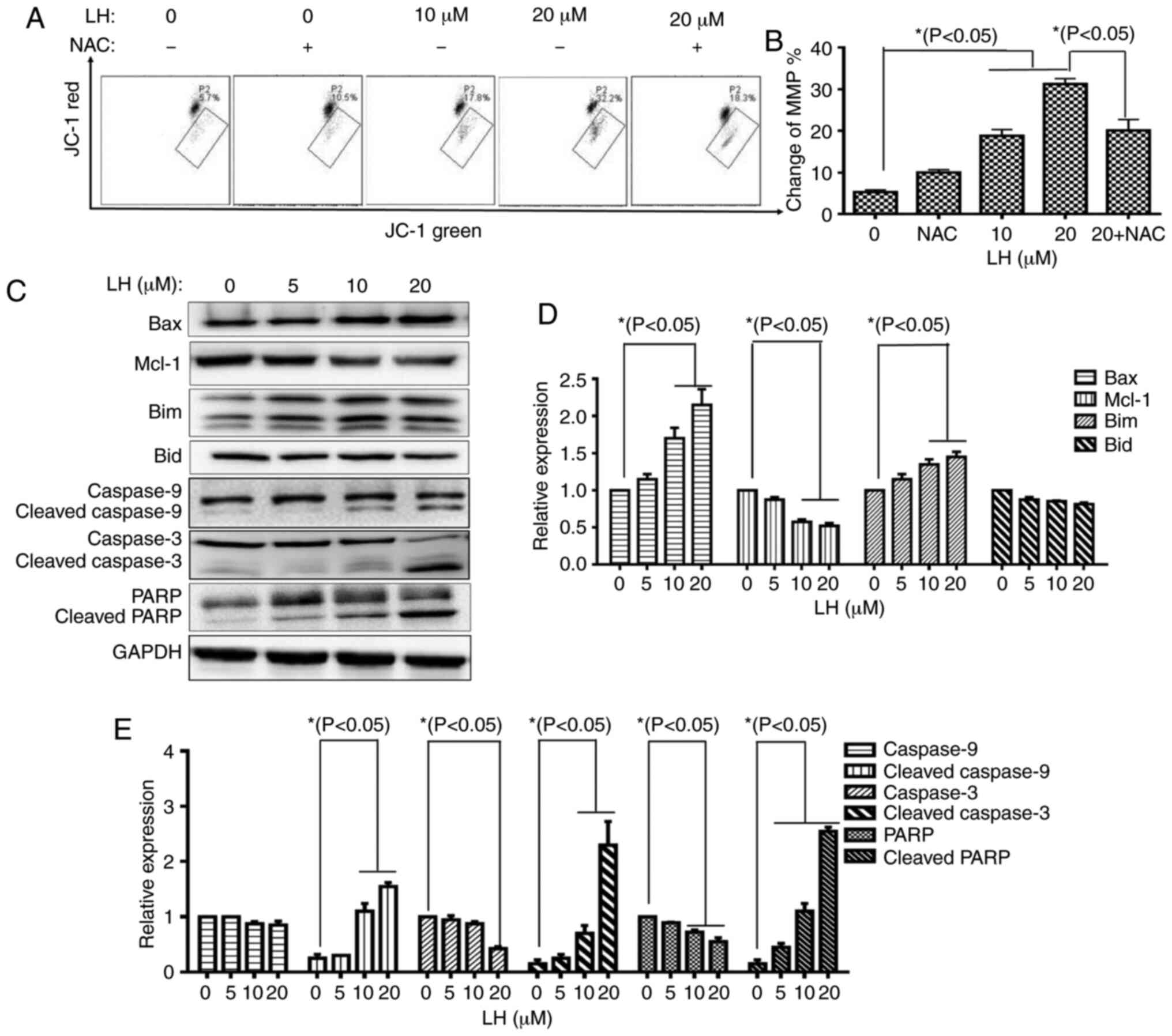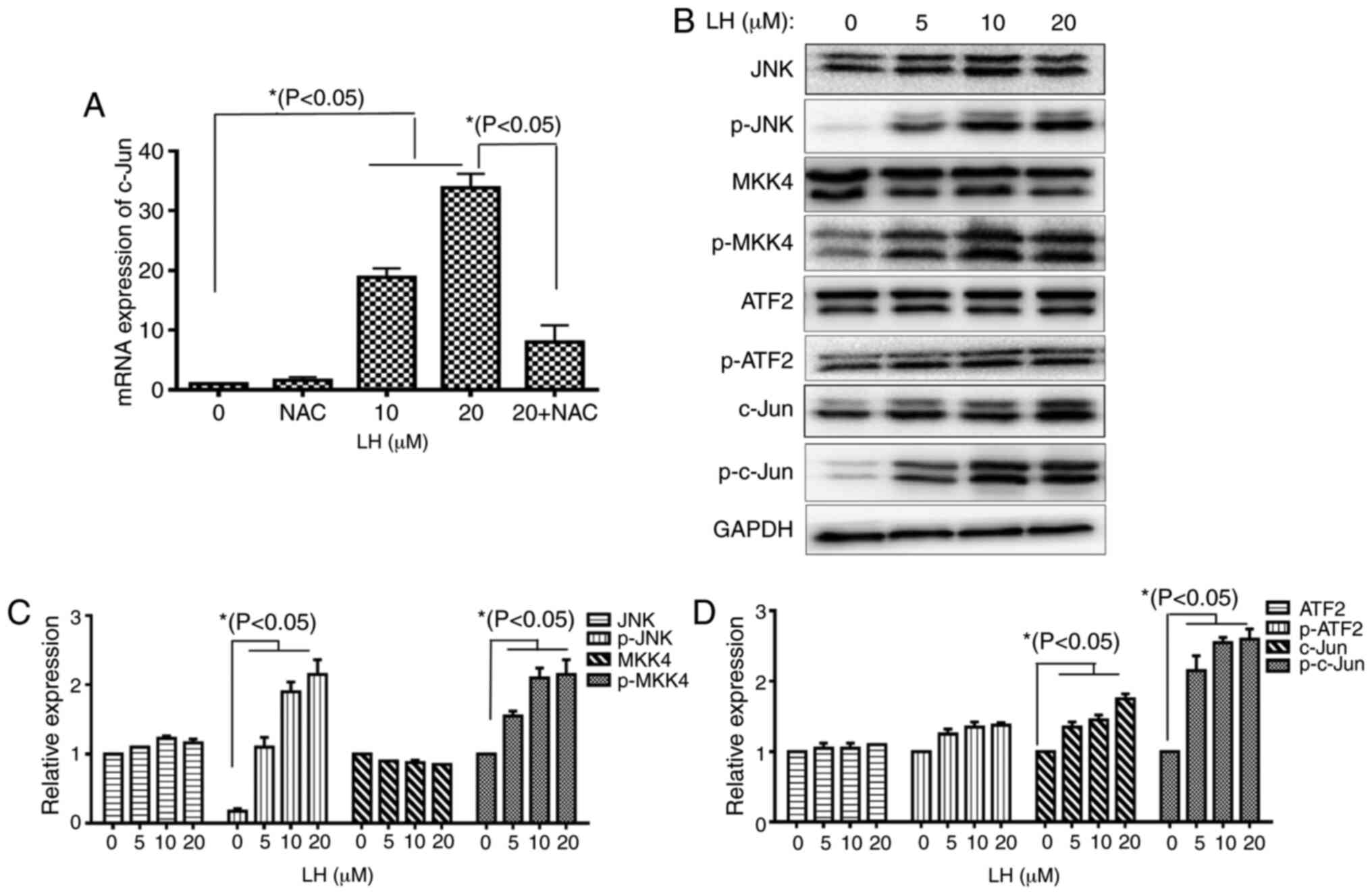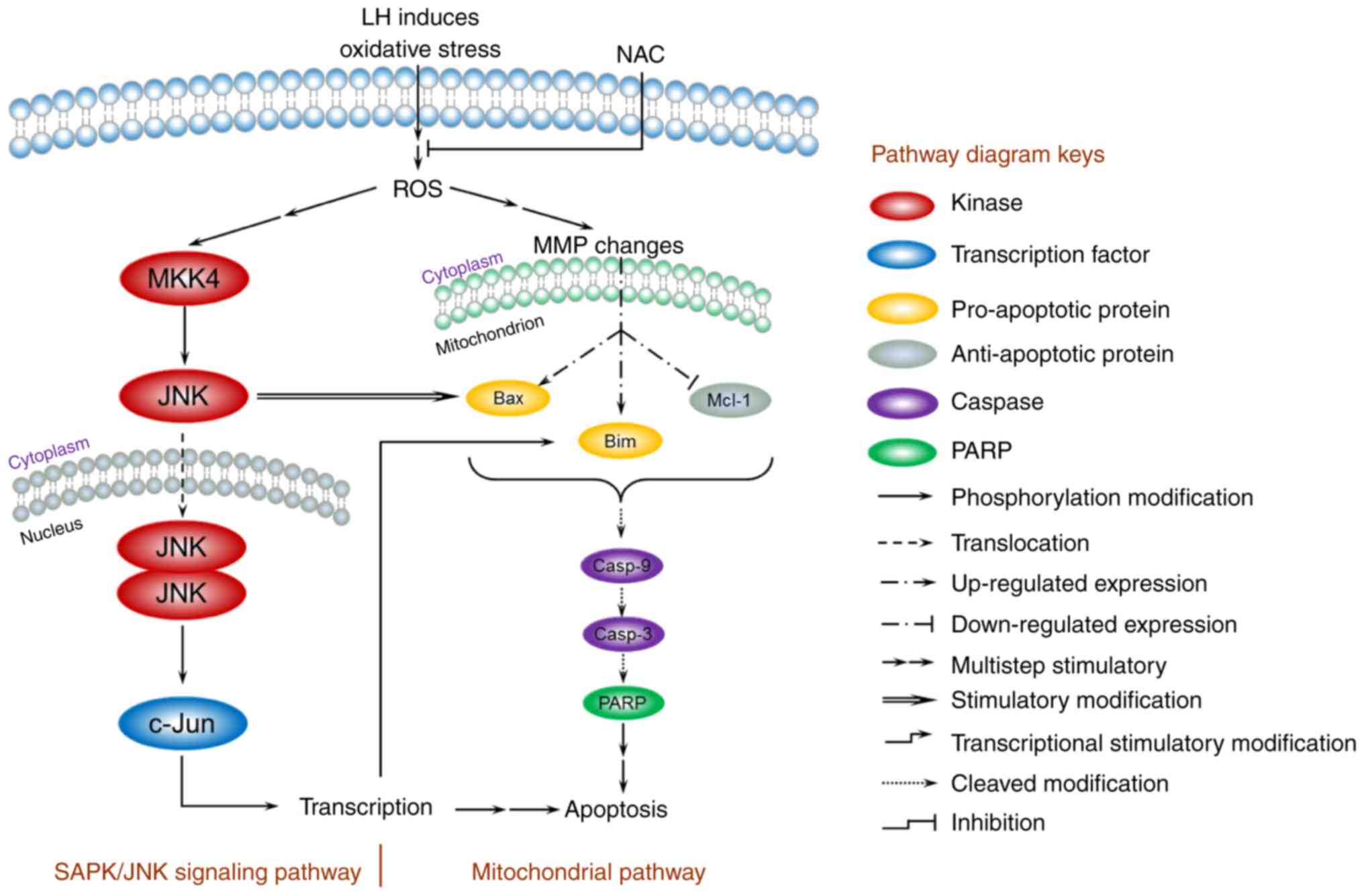|
1
|
Bray F, Ferlay J, Soerjomataram I, Siegel
RL, Torre LA and Jemal A: Global cancer statistics 2018: GLOBOCAN
estimates of incidence and mortality worldwide for 36 cancers in
185 countries. CA Cancer J Clin. 68:394–424. 2018. View Article : Google Scholar : PubMed/NCBI
|
|
2
|
Ferlay J, Colombet M, Soerjomataram I,
Mathers C, Parkin DM, Piñeros M, Znaor A and Bray F: Estimating the
global cancer incidence and mortality in 2018: GLOBOCAN sources and
methods. Int J Cancer. 144:1941–1953. 2019. View Article : Google Scholar : PubMed/NCBI
|
|
3
|
Wei M, Wu Y, Liu H and Xie C: Genipin
induces autophagy and suppresses cell growth of oral squamous cell
carcinoma via PI3K/AKT/MTOR pathway. Drug Des Devel Ther.
14:395–405. 2020. View Article : Google Scholar : PubMed/NCBI
|
|
4
|
Su L, Wang S, Yuan T, Xie X, Fu X, Ji P,
Zhong L and Liu W: Anti-oral squamous cell carcinoma effects of a
potent TAZ inhibitor AR-42. J Cancer. 11:364–373. 2020. View Article : Google Scholar : PubMed/NCBI
|
|
5
|
Xu Z, Jiang P and He S: Identification for
exploring underlying pathogenesis and therapy strategy of oral
squamous cell carcinoma by bioinformatics analysis. Med Sci Monit.
25:9216–9226. 2019. View Article : Google Scholar : PubMed/NCBI
|
|
6
|
Bernier J, Domenge C, Ozsahin M,
Matuszewska K, Lefèbvre JL, Greiner RH, Giralt J, Maingon P,
Rolland F, Bolla M, et al: Postoperative irradiation with or
without concomitant chemotherapy for locally advanced head and neck
cancer. N Engl J Med. 350:1945–1952. 2004. View Article : Google Scholar : PubMed/NCBI
|
|
7
|
Bernier J, Cooper JS, Pajak TF, van
Glabbeke M, Bourhis J, Forastiere A, Ozsahin EM, Jacobs JR, Jassem
J, Ang KK and Lefèbvre JL: Defining risk levels in locally advanced
head and neck cancers: A comparative analysis of concurrent
postoperative radiation plus chemotherapy trials of the EORTC
(#22931) and RTOG (# 9501). Head Neck. 27:843–850. 2005. View Article : Google Scholar : PubMed/NCBI
|
|
8
|
Ju WT, Ma HL, Zhao TC, Liang SY, Zhu DW,
Wang LZ, Li J, Zhang ZY, Zhou G and Zhong LP: Stathmin guides
personalized therapy in oral squamous cell carcinoma. Cancer Sci.
111:1303–1313. 2020. View Article : Google Scholar : PubMed/NCBI
|
|
9
|
Thiagarajan S, Dhar H, Bhattacharjee A,
Fatehi KS, Shah SB, Chaukar D, Nair D, Deshmukh A, Prabhash K,
Joshi A, et al: Patterns of failure and outcomes in cT4 Oral
squamous cell carcinoma (OSCC) undergoing upfront surgery in
comparison to neo-adjuvant chemotherapy (NACT) followed by surgery:
A matched pair analysis. Oral Oncol. 100:1044552020. View Article : Google Scholar : PubMed/NCBI
|
|
10
|
Utaipan T, Boonyanuphong P, Chuprajob T,
Suksamrarn A and Chunglok W: A trienone analog of curcumin,
1,7-bis(3-hydroxyphenyl)-1,4,6-heptatrien-3-one, possesses ROS- and
caspase-mediated apoptosis in human oral squamous cell carcinoma
cells in vitro. Appl Biol Chem. 63:72020. View Article : Google Scholar
|
|
11
|
Wang C, Liu XQ, Hou JS, Wang JN and Huang
HZ: Molecular mechanisms of chemoresistance in oral cancer. Chin J
Dent Res. 19:25–33. 2016.PubMed/NCBI
|
|
12
|
Shah O'Brien P, Xi Y, Miller JR, Brownell
AL, Zeng Q, Yoo GH, Garshott DM, O'Brien MB, Galinato AE, Cai P, et
al: Disulfiram (Antabuse) activates ROS-dependent ER stress and
apoptosis in oral cavity squamous cell carcinoma. J Clin Med.
8:6112019. View Article : Google Scholar
|
|
13
|
Yu CI, Chen CY, Liu W, Chang PC, Huang CW,
Han KF, Lin IP, Lin MY and Lee CH: Sandensolide induces oxidative
stress-mediated apoptosis in oral cancer cells and in zebrafish
xenograft model. Mar Drugs. 16:3872018. View Article : Google Scholar
|
|
14
|
Dias RB, de Araújo TBS, de Freitas RD,
Rodrigues ACBDC, Sousa LP, Sales CBS, Valverde LF, Soares MBP, Dos
Reis MG, Coletta RD, et al: β-Lapachone and its iodine derivatives
cause cell cycle arrest at G 2/M phase and reactive oxygen
species-mediated apoptosis in human oral squamous cell carcinoma
cells. Free Radic Biol Med. 126:87–100. 2018. View Article : Google Scholar : PubMed/NCBI
|
|
15
|
Ansari SS, Sharma AK, Soni H, Ali DM, Tews
B, König R, Eibl H and Berger MR: Induction of ER and mitochondrial
stress by the alkylphosphocholine erufosine in oral squamous cell
carcinoma cells. Cell Death Dis. 9:2962018. View Article : Google Scholar : PubMed/NCBI
|
|
16
|
Cao Z, Yu D, Fu S, Zhang G, Pan Y, Bao M,
Tu J, Shang B, Guo P, Yang P and Zhou Q: Lycorine hydrochloride
selectively inhibits human ovarian cancer cell proliferation and
tumor neovascularization with very low toxicity. Toxicol Lett.
218:174–185. 2013. View Article : Google Scholar : PubMed/NCBI
|
|
17
|
Ji Y, Yu M, Qi Z, Cui D, Xin G, Wang B,
Jia W and Chang L: Study on apoptosis effect of human breast cancer
cell MCF-7 induced by lycorine hydrochloride via death receptor
pathway. Saudi Pharm J. 25:633–637. 2017. View Article : Google Scholar : PubMed/NCBI
|
|
18
|
Xin G, Yu M, Hu Y, Gao S, Sun Y, Yu W, He
J and Ji Y: Effect of lycorine on the structure and function of
hepatoma cell membrane in vitro and in vivo. Biotech Biotechnol
Equip. 34:104–114. 2020. View Article : Google Scholar
|
|
19
|
Lamoral-Theys D, Andolfi A, Van
Goietsenoven G, Cimmino A, Le Calvé B, Wauthoz N, Mégalizzi V, Gras
T, Bruyère C, Dubois J, et al: Lycorine, the main phenanthridine
Amaryllidaceae alkaloid, exhibits significant antitumor activity in
cancer cells that display resistance to proapoptotic stimuli: An
investigation of structure-activity relationship and mechanistic
insight. J Med Chem. 52:6244–6256. 2009. View Article : Google Scholar : PubMed/NCBI
|
|
20
|
Wang C, Wang Q, Li X, Jin Z, Xu P, Xu N,
Xu A, Xu Y, Zheng S, Zheng J, et al: Lycorine induces apoptosis of
bladder cancer T24 cells by inhibiting phospho-Akt and activating
the intrinsic apoptotic cascade. Biochem Biophys Res Commun.
483:197–202. 2017. View Article : Google Scholar : PubMed/NCBI
|
|
21
|
Livak KJ and Schmittgen TD: Analysis of
relative gene expression data using real-time quantitative PCR and
the 2(-Delta Delta C(T)) method. Methods. 25:402–408. 2001.
View Article : Google Scholar : PubMed/NCBI
|
|
22
|
Sharma A, Boise LH and Shanmugam M: Cancer
metabolism and the evasion of apoptotic cell death. Cancers
(Basel). 11:11442019. View Article : Google Scholar
|
|
23
|
L Z: Progress on comprehensive treatment
of nasopharyngeal cancer. Cancer Res Prev Treat. 46:667–671.
2019.
|
|
24
|
An W, Lai H, Zhang Y, Liu M, Lin X and Cao
S: Apoptotic pathway as the therapeutic target for anticancer
traditional Chinese medicines. Front Pharmacol. 10:7582019.
View Article : Google Scholar : PubMed/NCBI
|
|
25
|
Roy M, Liang L, Xiao X, Feng P, Ye M and
Liu J: Lycorine: A prospective natural lead for anticancer drug
discovery. Biomed Pharmacother. 107:615–624. 2018. View Article : Google Scholar : PubMed/NCBI
|
|
26
|
Zhao G, Wang Y, Yang C, Zhao L, Guo L, Li
L and Wei Z: Interplay between autophagy and apoptosis in lycorine
hydrochloride-induced cytotoxicity of HCT116 cells. Nat Prod
Commun. 14:1934578X19862102019. View Article : Google Scholar
|
|
27
|
Li MH, Yang P, Yang T, Zhang K, Liu Y, Liu
J, Li LM, Luo XY, Yang SX, Zou Q and Zhang CJ: A novel
water-soluble benzothiazole derivative BD926 triggers ROS-mediated
B lymphoma cell apoptosis via mitochondrial and endoplasmic
reticulum signaling pathways. Int J Oncol. 49:2127–2134. 2016.
View Article : Google Scholar : PubMed/NCBI
|
|
28
|
Tomicic MT, Meise R, Aasland D, Berte N,
Kitzinger R, Krämer OH, Kaina B and Christmann M: Apoptosis induced
by temozolomide and nimustine in glioblastoma cells is supported by
JNK/c-Jun-mediated induction of the BH3-only protein BIM.
Oncotarget. 6:33755–33768. 2015. View Article : Google Scholar : PubMed/NCBI
|
|
29
|
Uzu M, Sato H, Shimizu A, Shibata Y, Ueno
K and Hisaka A: Connexin 43 enhances Bax activation via JNK
activation in sunitinib-induced apoptosis in mesothelioma cells. J
Pharmacol Sci. 134:101–107. 2017. View Article : Google Scholar : PubMed/NCBI
|















